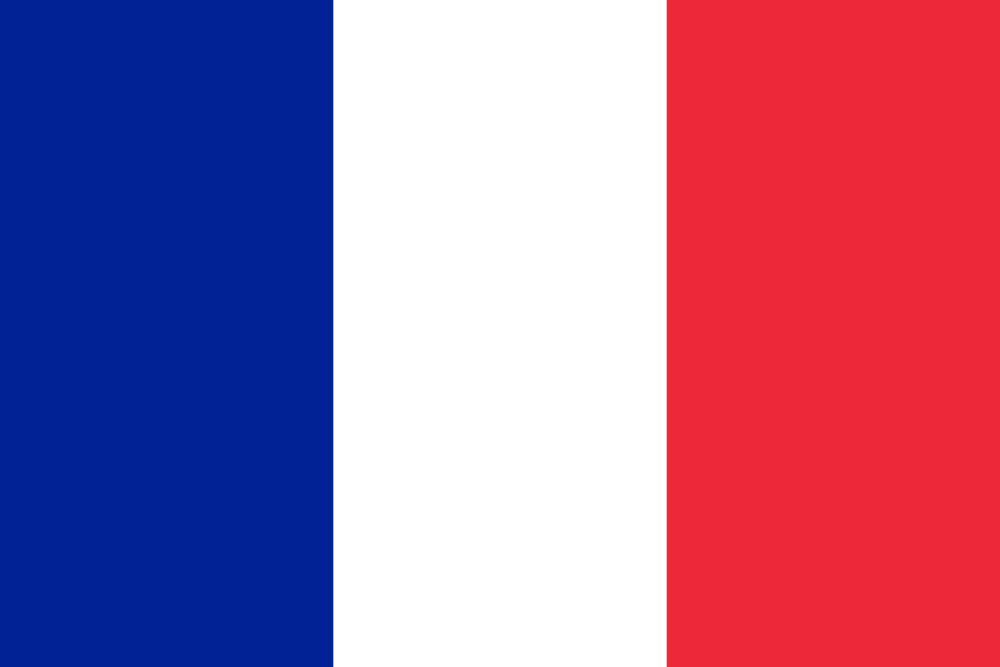Table of Contents
The National Flag of France- Description, History, and Meaning

The French Constitution of 1958, mentions, “the national emblem is the tricolor flag, blue, white, red”, in Article 2.
When it comes to describing the France flag, the tricolor flag has the most interesting history and multiple variations- all of them are used equally.
Initially, the royal government of the country had several flags, most of which had white color- the ancient color of France. The tricolor design was first adopted in 1794 and thereafter, several changes have been made to the designs and color distribution to finally introduce the one used today.
Design of the Flag of France
You may be wondering, what does the France flag look like?
Having a simple and aesthetic design featuring equally divided vertical bars of three different colors remains the inspiration for flag designing for several other nations.
France Flag has a proportion of 2:3 wherein the color scheme of the vertical tri-bands is equally divided into three parts blue on the hoist side, white in the middle, and red on the remaining part.
Color Versions of the French Flag
There are two color versions of the France Flag- light and dark.
Jacques-Louis David first conceptualized the dark version of the tricolor scheme that was adopted on 15 February 1974. There are two designs seen in the dark version-
- Having vertical bands of equal width
- Having vertical bars of varying widths (30:33:37)- presently, the official flag of the French Navy
The present-day National Flag of France is a light version of the tricolor (Tricolore in French) officially adopted in June 1976. This version was launched by President Valery Giscard d’Estaing for the convenient appearance of the flag on television during governmental speech broadcasting. Later, this version also became popular in digital media.
Earlier, the dark version tricolor adopted by the regulation of 17 May 1853 also had the same colors and order but with varying vertical band proportions of 30:33:37 for blue, white, and red respectively. This design of the flag was adopted by French Navy in 1853 and continues to be their official flag to date.
Today the light version flags are used in the official State buildings. However, the barracks, town halls, and public buildings in the country still use the dark version.
The symbolism of France Flag
The three colors on the flag have in-depth significance representing the France symbols.
The blue and red colors, identified with Saint Martin and Saint-Denis respectively, are used on the coat of arms of Paris. These are also the ancient colors of the capital city. These two colors of the oriflamme are also related to the patroness of France-Virgin Mary. The Paris militia also tied blue and red cockades on their hat during the storming of the Bastille in 1789.
As described by Lafayette, the traditional French color- white was used as the chief color on the France flag for several centuries. White is the traditional color of France and also the chief color of the Bourbon royal dynasty. The royalists used white flags and wore white cockades on their hats. The color white on the current flag represents the King.
The tricolor also represents the three prime estates of the French Ancient Regime- blue for the bourgeoisie, red for the nobility, and white symbolizing clergy. An emblem of the Fifth Republic, the merger of the three colors also signifies the patriotism and abatement between the republicans (using red) and royalists (using white).
The tricolor combination also symbolizes the three elements of the radical motto-
- Blue- Liberte (freedom)
- White- Egalite (equality)
- Red- Fraternite (brotherhood)
History of the France Flag
The history of the French flag dates back to the early Middle Age when the King of France used to raise the Oriflamme (the golden flame) during the war.
Oriflamme- Sacred Banner at the Monastery of Saint-Denis near Paris
Oriflamme is the holy banner of the Abbey (monastery) at Saint-Denis that was eventually adopted as the royal banner of the country. The red banner had three to five spikes meaning a banner with pointed ends.
The Oriflamme still remains the witness to the heinous cruelty of the French royalty, especially during the Hundred Years of War wherein prisoners were taken for ransom. It was a rule that the prisoners will not be taken until the lowering of the banner.
Eventually, blue, red, and white colors were associated with the French army and the reigning house of France. The Kings wore a blue coat embellished with the golden fleurs-de-lis above the flowing red gown. In 1328, the coat-of-arms in blue color had a golden fleur-de-lis with red borders.
During the 12th and 13th centuries, the Kingdom of France had a blue square banner with small golden-yellow lilies all over. Later, this design was modified into a blue rectangular Capetian flag with three large lilies in golden yellow color widely used during the French Renaissance.
The French royal family used the White flag with golden lilies until 1789.
Naval Flag of the Kingdom of France
The navy during the reign of the Bourbons, used the blue flag with the royal shield with a white cross.
The Tricolor Flag
The tricolor flag concept was inspired by the various cockades worn on the hats during the French revolution. On 13 July 1789, the Paris militia adopted the red and blue cockade on their hats.
Marquis de Lafayette, the French General Gilbert du Motier, the creator of the tricolor design proposed the inclusion of a white stripe between the blue and red colors. Based on this proposition for nationalizing the France flag, the tricolor cockade of blue, white, and red was adopted on 27 July 1789.
The Constituent Assembly approved the Drapeau Tricolore design with three vertical stripes of blue, white, and red on 24 October 1790. A resolution was passed on 15 February 1794 to fly the tricolor as the national flag of the country.
However, the official flag despite the government regulations was rarely flown. From 1794-to 1800 or thereabout, the Jacobian Club’s red flag was mainly used. During the reign of Napoleon Bonaparte from 1804-to 15, the tricolor flag gained prominence.
During the Bourbon Restoration after the abdication of Napoleon in April 1814, the royal white flag with the golden coat-of-arms was used as the official flag of the country from 1815-30.
During the reign of Louis Philippe on the aftermath of the July revolution in 1830, the tricolor gained prominence as the national flag.
National Emblem of France
The tricolor has deeper significance in the history of France. It was instituted as the National Emblem of the Republic following the Constitution of 1948 and 1958 (Article 2).
What is the Flag of France Called in French?
The ‘French Flag’ is called ‘Drapeau Francais’ in French. The term ‘Drapeau’ is a masculine noun that means flag in English. The term ‘French’ is called Francais- an adjective in the French language.
However, if you want to add the definite article ‘the’ to France Flag, use the term le/la (masculine). Therefore, the term ‘The Flag of France’ is called ‘Drapeau de la France’ in the French language.
Following are some terms associated with the flag and their pronunciation in French.
The tricolor- Le tricolore
The National Flag of France- Le Drapeau National de la France
Flag Desecration in France
The desecration of the France Flag was accorded judicial consideration in 2003 when the desecration was declared a legal offense.
Jacques Chirac, the President of the Republic, proclaimed the new flag and national anthem desecration law (Law No. 2003-239 pour la Securite interieure) on 18 March 2003.
The Title V of the Law under Article 113 states that the desecration of the National Anthem and Tricolor Flag in public during official events organized and controlled by the public authorities will be considered an offense imposing a fine of 7500 Euros.
The desecration is also a punishable offense when such an act is committed collectively wherein the offenders may be sentenced to jail for 6 months in addition to the imposition of a fine.
Facts about the Tricolor French Flag
The tricolor of the France flag is also depicted on the Sash worn on the right shoulder by the mayors and members of the Parliament during all public events and ceremonies.
In 2015, the tricolor emoji (Emoji 1.0) was added to all supported platforms showing the regional indicator symbol letters F followed by R.
During the military parade on Bastille Day, 9 pilots of the French Air Force produce the plume of smoke in the tricolor in an event called Patrouille de France. This event is known as the French Acrobatic Patrol (Patrouille Acrobatique de France).
The tricolor France Flag is seen in some famous paintings including:
- The Siege of Paris (1884)- Ernest Meissonnier
- Serment de l’Armee fait a l’Empereur (1810)- Jacques- Louis David
- Terrace at Saint-Adresse (1867)- Claude Monet
Today the flag of France is flown on all public buildings in the country. It is an integral part of public ceremonies, commemorations, and events. The flag is also situated at the backdrop of all media addresses by the government officials and the French President.
